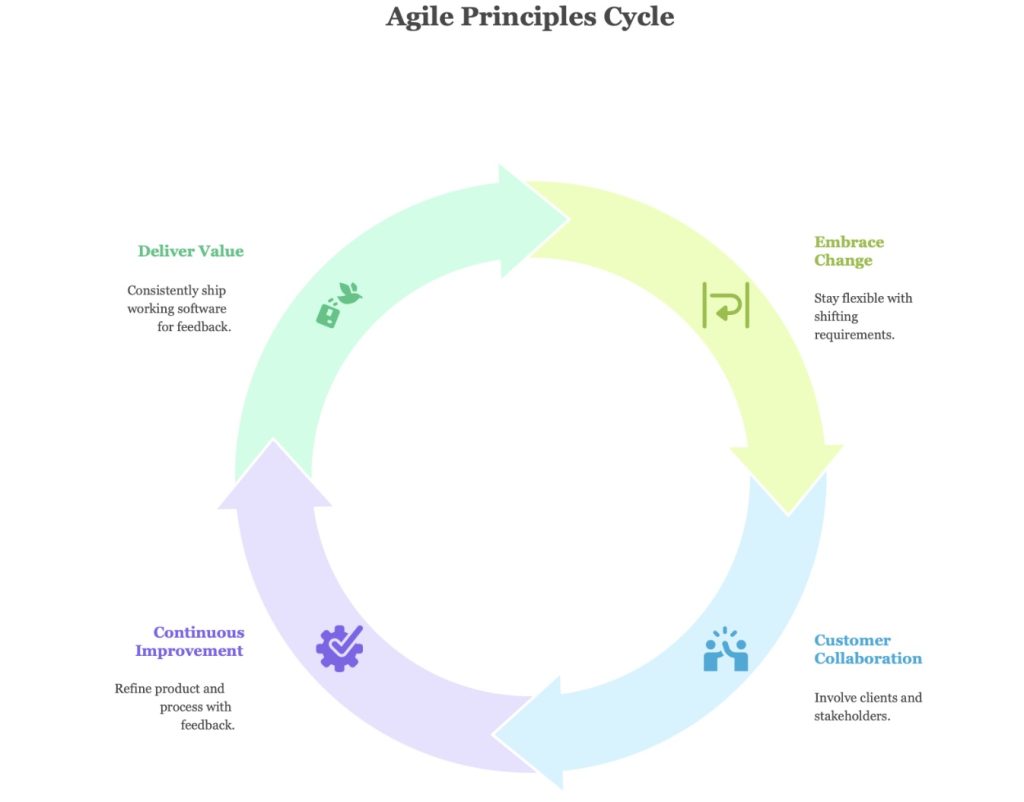Agile in the Age of AI Coding – Lessons for Web Development Teams
September 30, 2025 0 commentsAgile in the Age of Vibe Coding: What Changes, What Stays?
Introduction: Agile Beyond Buzzwords
For more than two decades, Agile has been the driving philosophy behind modern software development. It’s more than a collection of buzzwords or project management tools; it’s a mindset focused on delivering value through small cycles, fast feedback, and a deep commitment to adaptability. Agile taught us to stop building in rigid, monolithic phases and start collaborating in dynamic, iterative loops.
Now, a new paradigm is capturing the industry’s attention: “vibe coding.” Developers are increasingly experimenting with AI pair programmers like GitHub Copilot and Cursor, which can generate vast chunks of code from simple, descriptive prompts. The speed is intoxicating, and the potential is immense. This rapid evolution raises a critical question for development teams everywhere: Does Agile still matter in an era where code can be generated almost instantly?
The answer is a resounding yes. In fact, it may matter more than ever.
Agile at Its Core: Direction Over Tools
To understand why Agile remains relevant, we must remember what it has always been about. Agile was never concerned with how developers type code. Its focus has always been on the bigger picture:
- Delivering Value in Short Iterations: Consistently shipping working software allows for real-world feedback.
- Embracing Change: Staying flexible when requirements or market conditions shift is a core strength.
- Customer Collaboration: Keeping clients and stakeholders involved throughout the process ensures the final product solves the right problem.
- Continuous Improvement: Using feedback to constantly refine both the product and the process.
Whether a developer writes every line of code by hand or collaborates with an AI to generate it, these principles remain the compass for any successful project. AI changes the speed of the engine, but Agile is what steers the ship.

What Vibe Coding Brings to the Table
“Vibe coding” aptly describes the intuitive, prompt-driven style of development where AI assistants handle much of the boilerplate and implementation details. Instead of manually constructing every function, a developer describes their intent, and the AI produces a functional starting point. This introduces powerful new dynamics for Agile teams.
1. Shorter, More Intense Cycles
With AI assistance, functional prototypes and features can be produced in hours, not days or weeks. This allows Agile sprints to shrink into micro-iterations, enabling even faster feedback. The challenge shifts from development speed to the speed of decision-making. Can product owners and stakeholders provide feedback fast enough to keep up?
2. A Fundamental Shift of Focus
Teams will spend significantly less time wrestling with syntax, boilerplate code, and common algorithms. This frees up invaluable cognitive resources to focus on higher-level challenges: system architecture, user experience design, robust security models, and long-term maintainability. The developer’s role evolves from a pure creator to a strategic curator and integrator.
3. Amplified Pressure on Testing
AI can generate useful code with astonishing speed, but it can also introduce subtle bugs, security flaws, or inefficient logic with equal confidence. This makes Agile’s emphasis on automated testing, continuous integration (CI/CD), and Test-Driven Development (TDD) more critical than ever. A powerful CI/CD pipeline becomes the ultimate safety net, ensuring that AI-generated speed doesn’t come at the cost of quality.
4. The Need for Disciplined Knowledge Sharing
Without clear communication, teams risk creating “AI black box” systems where only the original prompter understands the logic. This is where Agile ceremonies gain renewed importance. Sprint reviews, retrospectives, and even daily stand-ups become essential forums for demystifying the code. Teams must discuss not just what was built, but how the AI was prompted and why its output was accepted, ensuring collective ownership and understanding.
5. Evolving Roles and Responsibilities
As developers become more like editors and architects, the role of the Product Owner becomes even more central. Since building things is faster and cheaper, the real challenge is choosing what to build. A clear vision and a ruthlessly prioritized backlog are paramount, because the cost of building the wrong feature is no longer just wasted time—it’s a massive squandering of opportunity.
A Remote Agency’s Perspective
At Macronimous, Agile isn’t a framework we adopted; it’s been our natural way of working for decades. As a remote-first web development agency, we rely on Agile principles to keep our distributed teams aligned, our clients engaged across different time zones, and our projects delivering value predictably. For us, Agile is the operational rhythm that makes remote collaboration seamless and effective.
That’s why we see vibe coding not as a disruption to Agile, but as a powerful force that Agile can help us harness. While we are still primarily human-coding our solutions in Laravel and other PHP frameworks—as AI-assisted coding is not yet fully mature or consistently reliable in this space—Agile has prepared us for this change. When the right tools stabilize, our Agile foundation will ensure we adopt them responsibly, always balancing speed with the trust and quality our clients expect.
The Verdict: Does Agile Still Matter?
Yes—and its importance is growing. AI provides the raw speed, but Agile provides the essential direction, discipline, and quality control.
- AI accelerates, but Agile steers. Without Agile principles, rapid code generation can quickly devolve into rapid chaos, leading projects far off course.
- Feedback loops protect quality. Agile’s insistence on short cycles and stakeholder validation ensures that what’s being built is frequently checked against real-world needs.
- Structure sustains trust. Agile ceremonies, automated testing, and a focus on working software ensure that projects don’t drift into an uncertain state of unverified, AI-generated code.
Agile is the compass; vibe coding is the engine. You need both to reach the right destination efficiently and safely.
Conclusion: The Future Is Agile-Plus
The real question isn’t whether Agile can survive the age of AI coding, but how it will evolve to guide it. At Macronimous, we see Agile as the enduring foundation and AI as a promising accelerator that will augment, not replace, human expertise.
For remote teams and forward-thinking agencies, the future of web development isn’t “Agile versus AI.” It is Agile-plus—a powerful synergy where timeless Agile principles combine with the unprecedented speed of AI to deliver better products, faster and more reliably than ever before.
Related Posts
-
February 25, 2016
Top 3 reasons to host your E-commerce website on AWS VPC
Top 3 reasons to host your E-commerce website on AWS VPC Amazon Web Services Virtual Private Cloud (AWS VPC) allows us to launch cloud resources into a virtual network that we define. This virtual network similar to a traditional network gives the benefits of using the highly scalable cloud infrastructure
Best Practices, Macronimous, Outsource to India, Welcome0 comments -
November 15, 2023
Reverse Brainstorming in Web Development: An Innovative Approach for Dynamic Web Applications
We at Macronimous like to share some regular techniques on web project management. Here is one such techniques. It is called Reverse Brainstorming! For web project managers who have never encountered the term, Reverse Brainstorming in Web Development, is a creative problem-solving technique that flips traditional brainstorming on its head.



